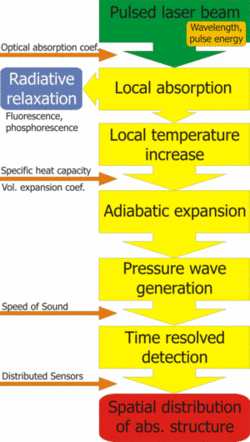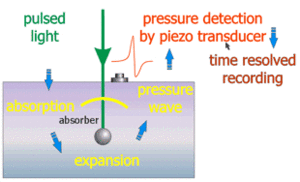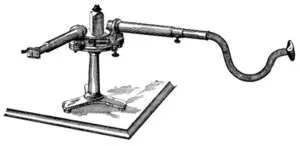Optoacoustic / Photoacoustic Spectroscopy

Optoacoustic Basics
Optoacoustic or photoacoustic (PA) spectroscopy is based on the absorption of light, leading to the local warming of the absorbing volume element. The subsequent expansion of the volume element generates a pressure wave proportional to the absorbed energy, which can be detected by means of microphones, piezo transducers or other pressure detectors. Hence, OA spectroscopy is a specific kind of absorption spectrometry, which, in contrast to the conventional transmission based absorption analyses, measures the actual absorbed energy. Scattered light does not contribute to the signal. Moreover, the signal is proportional to the excitation energy. Higher energy results up to certain limits in increases signals. Absorption measurements of opaque samples are possible only by means of OA spectroscopy. Time resolved analysis of the OA signal give information about depth and lateral distribution of the absorber. OA spectroscopy can be applied for the analysis of gases and aerosols, solids and liquids. All these fields of applications are covered by different projects in our labs.
Modulated light PA spectroscopy
This scheme mostly applies to gas phase analysis. The absorber can be a molecule as well as a particle (e.g. the PASS-system). Sensitivity in gas phase analysis can be improved by resonance amplification when the absorption takes place in an acoustical resonator. The advantage of the lock-in detection is the low sensitivity to background noise.

Pulsed PA spectroscopy
Pulsed OA spectroscopy is mainly applied for solid and liquid analysis. In inhomogeneous matrices, time resolved detection of the pressure signal together with the knowledge of the speed of sound in the medium gives an information about the depth where the absorption took place. Lateral distribution of the absorbers can be determined by scanning the pressure sensor, thus resulting tomographic scans.

Looking back...
As many other spectroscopic techniques, which are nowadays carried out with laser light sources, photoacoustic spectroscopy is much older than the development of the first laser in 1960. Already in 1881 A. G. Bell proposed his "spectrophone". This instrument was based on his experiments for the transmission of sound without cable connection. Then, the field lay dormant until the 70th of the last century, when Allan Rosencwaig and Gersho laid the theoretical basis the photoacoustic effect in solids, the so-called R-G Theory.